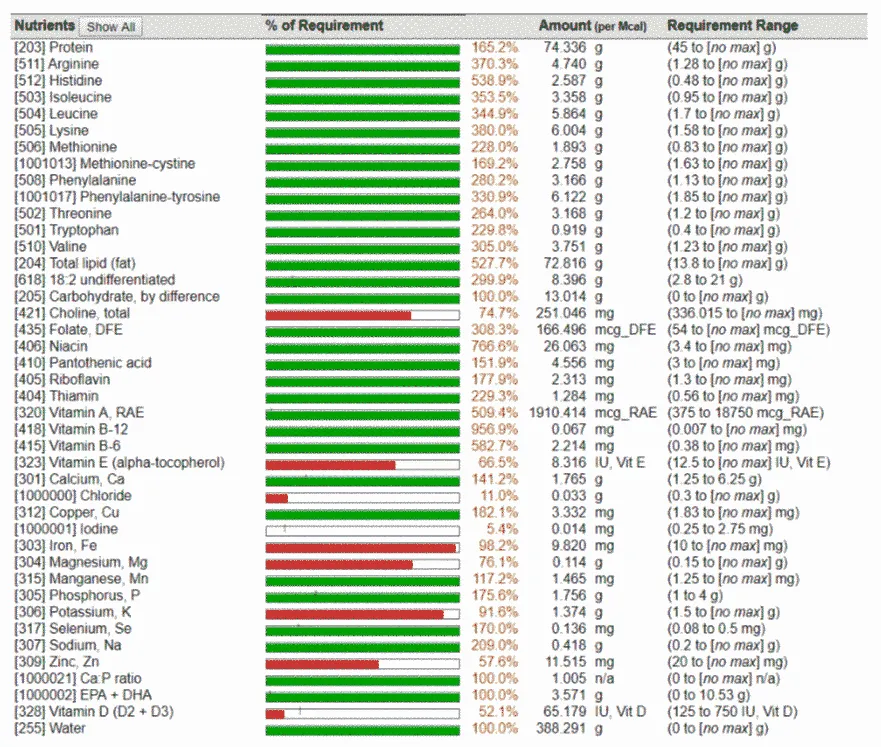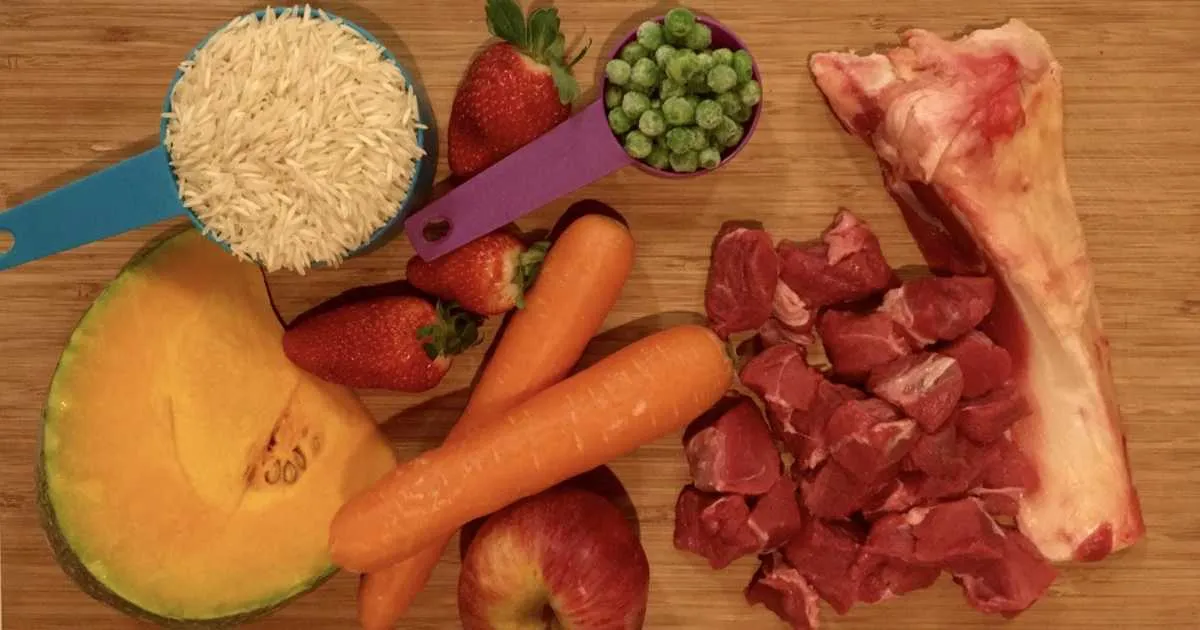The choice between feeding premium commercial dog food and a homemade raw diet is a common dilemma for many dog owners. While veterinarians often advocate for commercially prepared options due to their balanced nutrition, the trend towards raw and grain-free diets continues to grow. Rather than adhering strictly to one philosophy, it’s time to bridge this gap, ensuring that dog owners can safely and effectively provide homemade diets that are nutritionally complete. This article, penned by a veterinarian, aims to guide you through creating a balanced, vet-approved raw dog food recipe, demystifying the process and addressing common concerns. Understanding the nuances of canine nutrition, including selecting the right food containers, is crucial for your pet’s well-being. Ensuring your pet’s diet is both safe and beneficial starts with informed choices about what goes into their bowl and what kind of best dog bowls you use.
The Wolf Diet Myth: Evolution vs. Domestic Needs
Many raw feeding philosophies are built upon the premise that domestic dogs should consume a diet mimicking their wild ancestors, wolves. While this naturalistic approach holds intuitive appeal, a closer look reveals significant distinctions and potential pitfalls. As a veterinary professional, two primary concerns arise from this theory. Firstly, when many popular “wolf-based” raw diets are scientifically analyzed, they frequently fall short of the established nutritional requirements for dogs. If these imbalances were present in commercial foods, it would spark considerable controversy.
Secondly, there is compelling evidence indicating that the dietary needs and digestive capabilities of domesticated dogs have evolved to differ from those of wolves. Over thousands of years, dogs have adapted to living alongside humans, developing the ability to digest carbohydrates more efficiently, a trait not prominently shared by wolves. Therefore, while drawing inspiration from ancestral diets is a valuable starting point, a truly vet-approved raw dog food recipe must integrate these evolutionary changes in domestic canines, striving for optimal balance.
 Nutritional analysis of an unbalanced raw dog food diet
Nutritional analysis of an unbalanced raw dog food diet
This image illustrates the common nutritional shortfalls often found in homemade raw diets that are not carefully balanced. It highlights the importance of expert guidance to prevent deficiencies or excesses that could harm a dog’s long-term health. A responsible approach combines ancestral concepts with modern nutritional science to ensure comprehensive well-being for our canine companions.
Special Considerations for Raw Diets
Before diving into the specifics of ingredients and recipes, it’s vital to address certain special considerations, particularly concerning puppies and dogs with specific health conditions. These guidelines underscore the importance of tailored nutritional planning and caution in raw feeding.
Raw Diets for Puppies
The idea of feeding raw diets to puppies is a growing trend, with many breeders introducing it from a young age. However, veterinarians generally advise caution. The developmental stage of puppies makes them particularly vulnerable to nutritional imbalances. Inaccurate nutrient ratios, especially calcium and phosphorus, can lead to irreversible skeletal and developmental problems. Properly raising puppies is already complex, requiring careful attention to growth and health. Therefore, it is often recommended to wait until a dog reaches adulthood before transitioning to a raw diet, if at all, to minimize these risks. While new evidence regarding raw puppy diets is emerging, the consensus emphasizes extreme vigilance.
Raw Diets for Dogs with Cancer
It is crucial to understand that the general raw diet recipe outlined here is not suitable for dogs undergoing cancer treatment. Dogs battling cancer have unique metabolic needs, and their diets must be specifically formulated to support their immune system, manage inflammation, and potentially slow disease progression. These specialized diets often involve precise macronutrient ratios and specific supplements. If your dog has cancer, consult with a veterinary oncologist or a board-certified veterinary nutritionist to design a diet tailored to their specific medical condition and treatment plan.
Essential Ingredients for a Vet-Approved Raw Dog Food Recipe
Crafting a balanced raw diet involves careful selection of ingredients to ensure your dog receives all necessary nutrients without harmful deficiencies or excesses. This section breaks down the key components recommended for a vet-approved approach.
Meat Selection: Prioritizing Safe & Suitable Proteins
When it comes to raw meat for your dog, the type and quality are paramount. Red meats like lamb and beef are generally preferred over poultry. There are significant hazards associated with feeding raw chicken, not only to dogs but also to humans handling the meat, primarily due to the risk of bacterial contamination such as Salmonella. Consider the natural diet of wolves: they primarily hunt and consume mammals, not birds. While domestic dogs may tolerate raw chicken better in large quantities, this often indicates an over-reliance on muscle meat alone. A truly balanced raw diet, reflecting a “whole prey” concept, includes much more than just muscle tissue, incorporating organs, bones, and even some gut contents.
For safety, it is highly recommended to only feed raw meat that is fit for human consumption. This significantly reduces the risk of pathogens and ensures a higher standard of quality, although it does increase the cost. Options like goat, camel, or kangaroo can also be excellent choices. The regulatory environment for pet food varies widely, and ensuring the quality of raw meat sources is critical for your dog’s health.
Grains in the Canine Diet: A Balanced Perspective
The debate around grains in dog food is ongoing. While there isn’t definitive scientific evidence conclusively proving grains are harmful to dogs, they are also not strictly necessary for canine health. Therefore, in a raw diet, they can often be excluded. However, there’s one notable exception: rice. Rice has long been recognized for its beneficial properties for dogs, particularly in managing gastrointestinal upsets. Veterinarians often recommend it for its digestibility and soothing qualities for an upset stomach.
This is where the ideal “wolf” diet diverges from a modern vet-approved canine diet. While you can opt for brown rice, which offers excellent fiber and nutrients, Basmati rice is also a good choice due to its similar or lower glycemic index and easier preparation. Incorporating a small, cooked amount of rice can provide readily available energy and aid in digestion, making it a valuable component in certain raw dog food recipes.
The Role of Fillers: Balancing Richness
The term “filler” often carries a negative connotation in pet food discussions, implying inexpensive, low-nutrient ingredients. However, in the context of a homemade raw diet, carefully chosen fillers play a crucial role in balancing the richness of high-meat content. Wolves, in the wild, consume various elements beyond muscle meat, including fibrous plants, roots, insects, and the contents of their prey’s digestive tracts. These components help provide essential fiber, vitamins, and minerals, and contribute to satiety without over-providing protein and fat.
For homemade diets, pumpkin is an excellent choice. It’s highly fibrous, low in starch, and packed with beneficial nutrients. Other vegetables from your local farmer’s market can also be explored. However, it is absolutely critical to be aware of a list of what dogs can’t eat before experimenting. Certain foods are toxic to dogs and must be avoided at all costs.
Raw Fruits & Vegetables: Nutrient Boosters
Many dog owners find that their pets thoroughly enjoy raw fruits and vegetables, and these can be fantastic additions to a raw diet. They provide essential vitamins, minerals, and antioxidants that support overall health and immune function. Adding a variety of these fresh ingredients can make mealtime more exciting and nutritious for your dog.
However, caution is key. Always avoid grapes and raisins, which are highly toxic to dogs, and onions in all forms. Beyond these, most common fruits and vegetables can be given in moderation. To preserve heat-sensitive vitamins, add these raw ingredients after any cooked components have cooled. Alternatively, incorporate a fresh piece from your own healthy diet into your dog’s meal daily. Discovering what is the best vegetable for dogs to eat can enhance their diet significantly.
Calcium: The Bone of Contention
Calcium is a critical mineral for bone health, nerve function, and numerous other bodily processes. In a natural raw diet for wolves, raw bone consumption is the primary source of calcium. If you are comfortable and informed about feeding raw bones, this can be a natural way to provide the necessary calcium. However, it’s crucial to understand the risks and proper guidelines for raw bone feeding to minimize choking hazards or digestive issues.
For those hesitant about feeding raw bones, finely ground eggshell offers a safe and readily available alternative source of calcium. This allows you to accurately measure and add the required amount to your homemade recipe. Some owners feel confident allowing their dogs to chew on supervised raw bones, which can also contribute to dental health and a steady mineral supply.
A Sample Vet-Approved Raw Dog Food Recipe
This recipe is designed to provide a balanced foundation for an adult dog, taking into account both ancestral eating patterns and modern canine nutritional science. It offers a solid starting point for owners looking to provide vet-approved raw dog food recipes at home.
 Ingredients for a homemade raw dog food recipe
Ingredients for a homemade raw dog food recipe
This image displays the fresh, wholesome ingredients that form the basis of a balanced homemade raw diet, emphasizing the natural components that contribute to canine health.
This recipe serves the requirements of an 8kg (approximately 17.6 lbs) dog for 3-4 days.
Ingredients:
- 250g (approx. 0.55 lbs) chopped beef or lamb, raw
- 1 cup chopped carrots, raw
- 1 cup chopped apple, raw
- ¼ cup frozen peas, defrosted
- 1½ cups chopped pumpkin or squash
- ⅔ cup brown or basmati rice (will cook to approx. 3 cups)
- 4 teaspoons sunflower oil
- 4g fish oil (or supplement as directed by your vet)
- Optional: Additional supplements (see below)
Method:
- Cook the rice and pumpkin together until soft. Allow the mixture to cool completely to room temperature.
- In a large bowl, combine the cooled rice and pumpkin mixture with all the raw ingredients: chopped beef/lamb, carrots, apple, and defrosted peas. Most dogs enjoy peas raw for their texture and crunch.
- Add the sunflower oil and fish oil, mixing thoroughly to ensure even distribution.
- Feed the required daily quantity to your dog. Refrigerate the remainder in an airtight container.
- The prepared food can be safely refrigerated for up to 3 days or frozen for up to 2 weeks for longer storage.
Enhancing Your Homemade Raw Diet: Supplements and Additions
While the above recipe provides a strong foundation, it’s important to acknowledge that almost any homemade meal, raw or cooked, can have multiple vitamin and mineral deficiencies when prepared without specific analysis. Though dogs may tolerate minor imbalances for a period, long-term deficiencies can lead to health issues.
For optimal nutritional completeness, veterinarians often recommend incorporating a high-quality vitamin and mineral supplement designed for homemade diets. Products like “Balance IT” are specifically formulated to complement home-prepared meals and can be ordered internationally. If such specialized supplements are unavailable, a combination of individual supplements, ground and mixed into the cooled recipe, can help mitigate deficiencies. Examples include:
- 1 Cenovis® Zinc Tablet (25mg)
- 1 Trace Nutrients or Interclinical Copper Plus tablet (2mg)
- 1 g Iodised salt
- 1 Centrum® Advance Multivitamin/Multimineral Supplement
Many dog owners also like to add their favorite extra ingredients, such as chia seeds for omega fatty acids or sardines for an extra protein and nutrient boost. While these can be beneficial, always consult your veterinarian before introducing anything unusual or in large quantities, especially for dogs with existing health conditions. Be particularly cautious with large amounts of oil, as excessive fat intake can significantly increase the risk of pancreatitis, a painful and potentially life-threatening inflammation of the pancreas in dogs.
Determining the Right Portion Size for Your Dog
Accurately calculating your dog’s daily food portion is essential to maintain a healthy weight and ensure they receive adequate nutrition. This isn’t a one-size-fits-all calculation, as individual metabolism, activity levels, and age play a significant role.
Using the raw diet recipe provided above, a simple calculation can help you determine how long one batch will last for your dog: Divide 32 by your dog’s weight in kilograms (kg). For example, if you have a 4kg Maltese, the batch will provide food for 8 days (32 / 4 = 8).
 Appropriate portion sizes for dog food
Appropriate portion sizes for dog food
This image helps visualize how dog food portions might look, whether prepared at home or from commercial sources, aiding owners in consistent feeding practices.
Once you establish a starting portion, it’s crucial to diligently monitor your dog’s weight and body condition. Adjust the amount of food accordingly. No two dogs have identical caloric needs, even if they are of the same breed and size. Regularly assessing your dog’s energy levels, coat condition, and overall health will also provide clues as to whether their diet is appropriate. If you’re considering kinetic dog food or other specialized diets, professional guidance is even more important. For highly personalized dietary plans, especially if your dog has specific health needs or you desire higher meat levels, consulting with a veterinary nutritionist is highly recommended. These specialists can design a balanced homemade diet tailored precisely to your dog’s unique requirements and your preferences. Don’t hesitate to ask your vet for a referral to such an expert. For those special occasions, you might even consider visiting an ice cream shop for dogs near me as a rare treat.
Conclusion
Creating a vet-approved raw dog food recipe for your beloved companion requires dedication, research, and a commitment to nutritional accuracy. While the allure of a “natural” diet is strong, it’s vital to remember that domestic dogs have evolved, and their nutritional needs differ from their wild ancestors. By carefully selecting ingredients, balancing macronutrients, and considering essential supplements, you can provide a homemade diet that is both beneficial and safe. Always prioritize high-quality, human-grade ingredients and be vigilant about potential contaminants and nutritional deficiencies.
The journey of providing optimal nutrition for your dog is continuous. Regular consultation with your veterinarian is paramount, especially when making significant dietary changes or if your dog has specific health conditions. This proactive approach ensures that your pet receives all the necessary support for a long, healthy, and vibrant life. Empower yourself with knowledge, work with veterinary professionals, and watch your dog thrive on a well-planned, vet-backed diet.
Disclaimer and Author Information
Disclaimer: This homemade raw diet, like most such diets, has not been subjected to formal scientific analysis or testing for complete nutritional adequacy or safety against bacterial contamination. It is impossible to guarantee that it is nutritionally complete for all dogs or that bacterial contamination will not occur. The use of this diet is undertaken at the dog owner’s own risk. For increased safety, cooking the meat will significantly reduce bacterial risks without substantially altering the core nutritional profile of the diet. Always prioritize your pet’s health and safety.
This article was thoughtfully prepared by Andrew Spanner BVSc(Hons) MVetStud, a practicing veterinarian based in Adelaide, Australia. His insights are drawn from extensive experience in veterinary medicine, providing valuable expertise to dog owners seeking to understand their pets’ nutritional needs.
